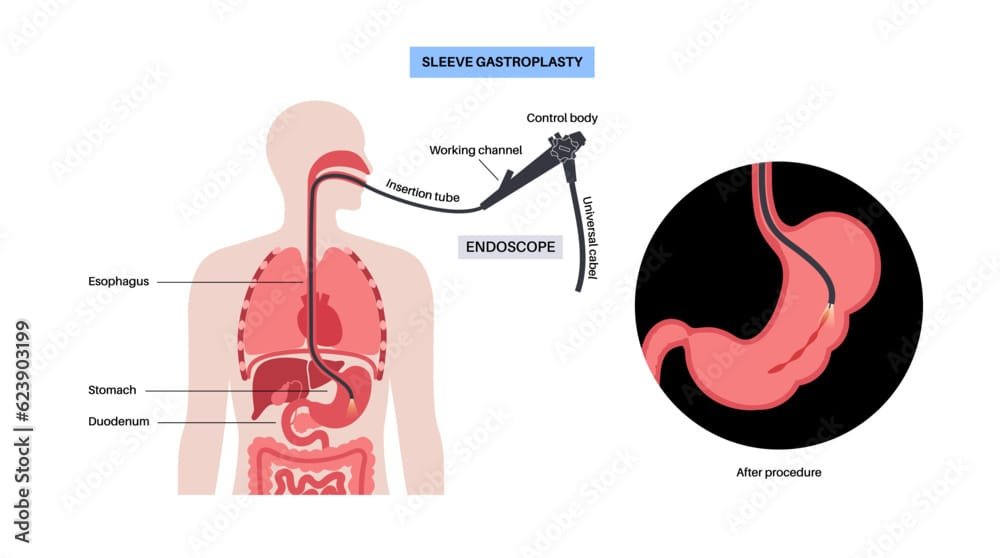
Endoscopic Sleeve Gastroplasty: A Non-Surgical Approach to Weight Loss
Weight loss is a journey that many people embark on, seeking healthier lifestyles and improved well-being. Among the numerous options available, Endoscopic Sleeve Gastroplasty (ESG) has emerged as a revolutionary, non-surgical procedure offering a viable alternative for those struggling with obesity. This blog will explore what ESG is, how it works, its benefits, and what you can expect from the procedure.
What is Endoscopic Sleeve Gastroplasty?
Minimal invasive surgery known as endoscopic sleeve gastroplasty (ESG) is used to lose weight. Unlike traditional surgical methods, ESG is performed endoscopically, meaning it involves no incisions or major surgery. The procedure aims to reduce the stomach’s size, thus limiting food intake and promoting significant weight loss.
How Does ESG Work?
During ESG, a gastroenterologist inserts an endoscope (a flexible tube with a camera and suturing device) through the mouth and into the stomach. The endoscope is used to place a series of sutures in the stomach, which reduce its volume by creating a sleeve-like shape. This new, smaller stomach can hold less food, helping patients feel full sooner and eat less.
Benefits of Endoscopic Sleeve Gastroplasty
- Minimally Invasive: One of the most significant advantages of ESG is that it is a non-surgical procedure. There are no large incisions, which reduces the risk of complications and speeds up recovery time.
- Effective Weight Loss: Studies have shown that patients undergoing ESG can lose a significant amount of weight, comparable to more invasive surgical procedures. The weight loss can lead to improvements in obesity-related conditions such as diabetes, hypertension, and sleep apnea.
- Short Recovery Time: Since ESG is performed endoscopically, patients typically experience a quicker recovery compared to traditional weight-loss surgeries. Most patients are able to resume their regular activities in a few of days.
- Reversible and Adjustable: ESG is reversible and can be adjusted if necessary, providing flexibility that traditional surgeries do not offer.
- Lower Risk: The non-surgical nature of ESG means there is a lower risk of infection and other complications associated with invasive procedures.
LOCATION :
Finding a reputable facility for Endoscopic Sleeve Gastroplasty near you is crucial for ensuring the best possible care and outcomes. Local options often include specialized gastroenterology clinics and hospitals equipped with state-of-the-art technology and experienced medical professionals. These facilities typically offer comprehensive pre-procedure evaluations, personalized treatment plans, and follow-up care to support your weight loss journey. Many clinics also provide access to multidisciplinary teams, including dietitians, psychologists, and fitness experts, to help you achieve lasting success. To find a clinic near you, consider seeking referrals from your primary care physician, reading online reviews, and researching the credentials and experience of the medical staff.
CLICK HERE
What to Expect During and After the Procedure
Before the Procedure: Patients will undergo a thorough medical evaluation to determine if ESG is the right choice. This includes consultations with a gastroenterologist, dietitian, and possibly a psychologist to ensure readiness for the lifestyle changes required.
During the Procedure: ESG is performed under general anesthesia and typically takes about 60 to 90 minutes. Since it is a non-surgical procedure, patients usually do not experience the same level of postoperative pain as with traditional surgeries.
After the Procedure: Following ESG, patients are monitored for a short period before being discharged. They will need to follow a specific diet plan starting with liquids and gradually progressing to solid foods. Regular follow-up visits are essential to monitor progress and address any concerns.
Is Endoscopic Sleeve Gastroplasty Right for You?
ESG is suitable for individuals who are obese and have been unable to achieve significant weight loss through diet and exercise alone. It is an option for those with a body mass index (BMI) of 30 or higher. However, it may not be appropriate for everyone, and a thorough evaluation by a healthcare professional is necessary to determine eligibility.
Conclusion
Endoscopic Sleeve Gastroplasty is a promising option for those seeking a non-surgical solution to weight loss. Its minimally invasive nature, effectiveness, and quicker recovery time make it an attractive alternative to traditional weight-loss surgeries. If you are considering weight-loss options, consult with your healthcare provider to see if ESG might be the right choice for you.
FAQs
Endoscopic Sleeve Gastroplasty (ESG) is a minimally invasive weight-loss procedure that reduces the size of the stomach using an endoscope. This results in a smaller stomach capacity, helping patients eat less and feel full sooner.
Unlike traditional weight-loss surgeries, ESG is performed without making large incisions. It uses an endoscope inserted through the mouth to place sutures in the stomach, making it a less invasive option with a quicker recovery time and lower risk of complications.
ESG is typically recommended for individuals with a body mass index (BMI) of 30 or higher who have not achieved significant weight loss through diet and exercise alone. A thorough medical evaluation is necessary to determine eligibility.
The benefits of ESG include significant weight loss, improvements in obesity-related conditions (such as diabetes and hypertension), a quicker recovery time compared to surgical options, a lower risk of complications, and the reversibility and adjustability of the procedure.
During the procedure, you will be under general anesthesia. An endoscope will be inserted through your mouth and into your stomach, where sutures will be placed to create a sleeve-like shape. The procedure usually takes about 60 to 90 minutes.
Ozempic can be taken with other diabetes medications, but it’s important to inform your healthcare provider about all the medications you are currently taking. They will advise you on the best combination of treatments to manage your diabetes effectively.
Recovery time for ESG is relatively short. Most patients can return to their normal activities within a few days. However, you will need to follow a specific diet plan and attend regular follow-up visits to monitor your progress.
As with any medical procedure, there are some risks, including infection, bleeding, and adverse reactions to anesthesia. However, the risks are generally lower compared to traditional weight-loss surgeries due to the minimally invasive nature of ESG.







